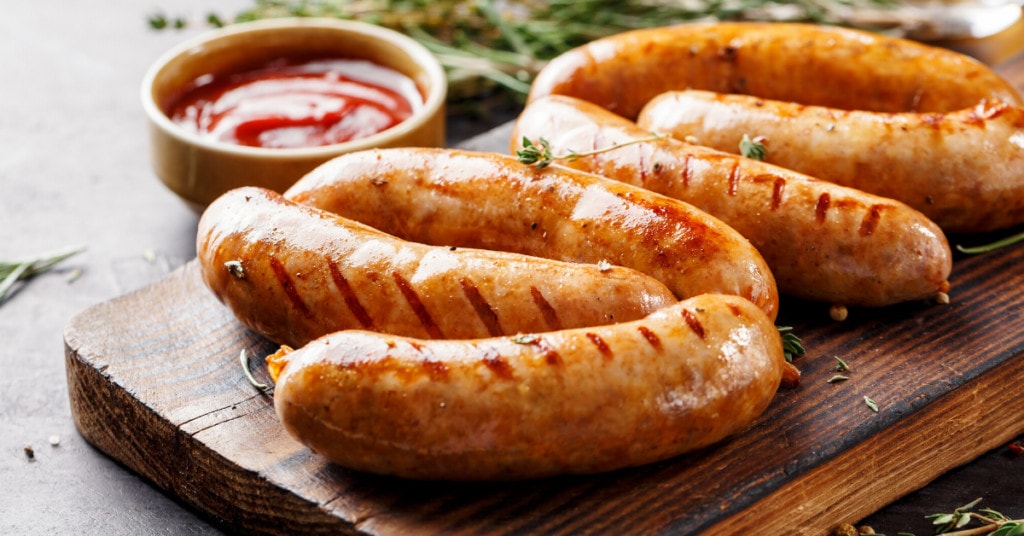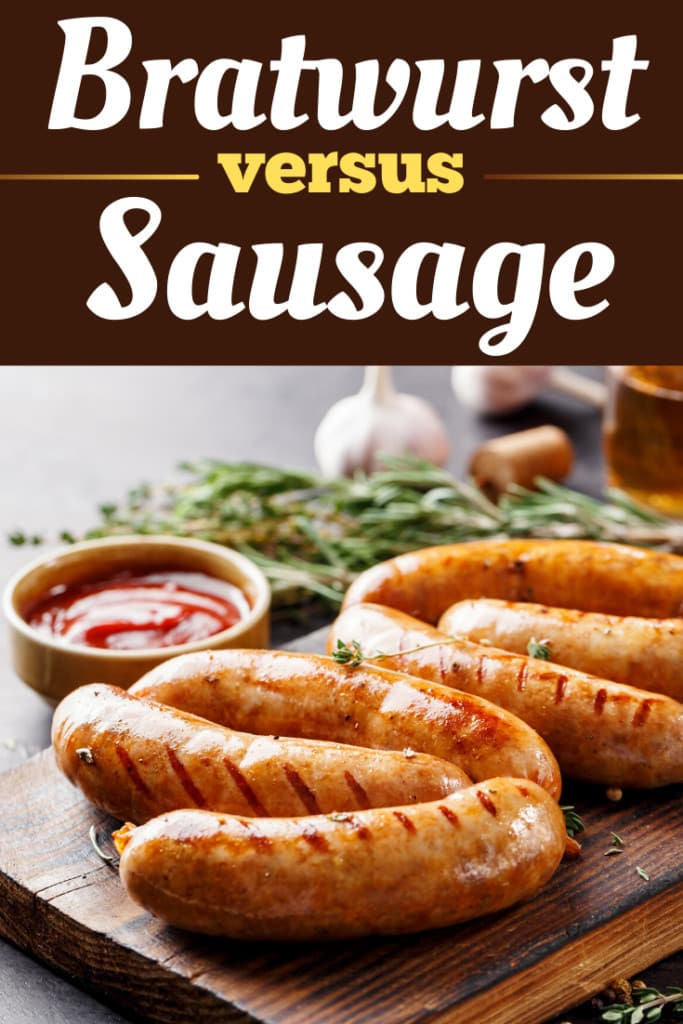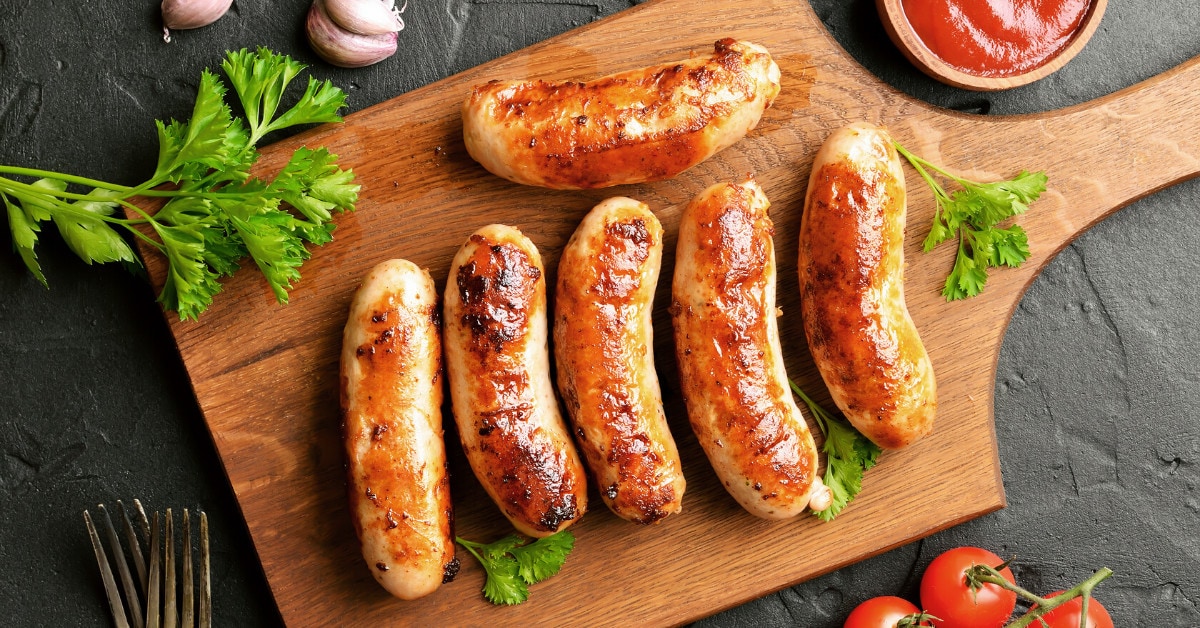If you’ve asked yourself one or all of these questions before, today is your lucky day. If you’re a meat lover, you know just how delicious sausages and brats are. They’re meaty, savory, and oh-so juicy. They’re fantastic on their own or eaten in a sandwich, flavored with mustard. They’re a staple at barbecues, tailgates, and Super Bowl parties. But can you tell them apart? These two words often get confused for one another, but I’m here to explain the difference between sausage and bratwurst.
What is Sausage?
Sausage is the generic term for any minced or ground meat product – whether it’s pork, beef, veal, lamb, chicken, or turkey. The meat is mixed with fat and flavored with salt. Spices, seasonings, and other ingredients are also added for more flavor. Some sausages contain breadcrumbs or grains to serve as fillers or extenders. Sausage can refer to skinless meat, meat patties, or meat stuffed in casings. These casings may be natural, such as animal intestine or plant cellulose, or made from artificial and synthetic materials. There are a wide variety of sausages, all having different types of meats, herbs, spices, and seasonings that make them unique. There are three primary methods to prepare sausages, each of them having a significant impact on the sausage’s flavor and texture.
Dried or cured. Drying or curing is a method used to preserve meat trimmings. The term “sausage” came from the Latin word, “salsicus,” which means seasoned with salt, which explains this method in a nutshell.
To make dried sausage, the meat is covered in salt and is hung outdoors for weeks and months to dry. They are not normally stuffed in a casing, because the skin will prevent the meat from drying. Since this method existed prior to the invention of the refrigerator, there is no need to refrigerate dried sausages. The salt and air “cooks” the meat, so you may eat the sausages without cooking or any other preparations, aside from slicing. Dried sausages include our favorite charcuterie, pizza toppings, and sandwich fillings – salami, pepperoni, and Spanish chorizo. When working with dried sausages, be sure to slice them as thin as you can, and serve/eat them at room temperature.
Smoked. Smoking is another method to preserve meat without refrigeration. Meats are flavored with herbs and spices, stuffed into casings, and then smoked. Most smoked sausages are sold cooked, however, you will also find fresh lightly smoked sausages in specialty stores. Smoked sausages include Kielbasa and Andouille.Fresh. These sausages have not been preserved. Raw meat stuffed is in casings and offered as-is. As such, you will need to cook them before you eat or serve them. There are several ways you can cook fresh sausages, from grilling, broiling, and boiling, to frying and baking. Fresh sausages include Italian pork sausage, Mexican chorizo, and breakfast sausage.Pre-cooked. These sausages make use of smooth, pureed meat fillings that are stuffed in casings. Some of these sausages pre-cook the meat fillings prior to being stuffed, but all of them are cooked post-stuffing just the same.
Despite being pre-cooked, you want to cook these sausages for a few minutes for maximum flavor. You may either boil, grill, broil, sear, or fry them. You may also cut them up and use them as ingredients in other dishes. These sausages include hot dogs, bologna, and frankfurters.
Interesting Facts about Sausage
The term sausage has been used all the way back in the 15th century BC. The earliest record of the word is in a play by Aristophanes, written in the 5th century BC. The first record of the word “sausagey” was in 1921, by DH Lawrence.During the 4th century BC, the Catholic Church prohibited the consumption of sausages, since they were linked to pagan festivals.Sausages are beloved all over the world, so much so, that an entire month is dedicated to celebrating them. October is National Sausage Month.Some of its biggest fans are the Brits, who spend almost 500 million pounds on sausages every year. That’s over 250,000 tons of sausage! There is even an organization in the UK devoted to sausages! The British Sausage Appreciation Society has over 5,000 members.The most common condiment linked to sausages is mustard. King Henry V even reportedly said, “War without fire is like sausages without mustard.”Sausages earned the nickname, “bangers,” during WW2. Back then, the scarcity of meat and other ingredients resulted in sausages with high water content. The water turned into steam as it cooked, causing the casings to explode.Wonder what type of meat goes into a sausage? Well, 50% of it comprises leftover parts, such as guts, organs, blood, and the head!The most expensive sausage costs $57 a link. The sausage was created by British Kevin Turner in 2015. It’s a combination of Mangalitsa pork (the same that Queen Elizabeth II gets), truffles, Stilton cheese, and a 1947 vintage port. Meanwhile, the longest sausage ever created is 26.75 miles long.Want to become a sausage expert? Head to Neumarks, Germany, and enroll in the Sausage Academy!
What is Bratwurst?
A Bratwurst, commonly referred to as a brat, is a type of link sausage usually made from pork. Other Bratwursts make use of a combination of meats, though, such as pork and beef, pork and veal, et cetera. Brats get their distinct flavor from fresh marjoram. Other herbs and seasonings such as sage, mace, cumin, nutmeg, coriander, paprika, ginger, cardamom, and caraway may also be added for more flavor. The meat is stuffed in a natural casing and is sold fresh. As such, you need to cook your brats before you eat them. Boiling, grilling, and pan-searing are all acceptable cooking methods. Apart from the meat and the seasonings, Bratwursts also have a high fat content. Hence, they’re not the healthiest of foods. Bratwursts hail from Germany, and there are a plethora (42 in total) of varieties that come from different regions. The differences in the type of meat, seasonings, cooking method, and size all contribute to the Brats’ varying flavors and textures. Some types of Brats include Zervelatwurst, Blutwurst, Plockwurst, Gelbwurst… the list goes on and on. The two most common ones, however, are Thüringen Bratwurst and Rindwurst. The former is a pale thin sausage made from pork, while the latter is red, thicker, red, and made from beef.
Interesting Facts about Bratwurst
The word “bratwurst” is said to have originated from the Old High German words, “brat,” which means “without waste,” and “wurst,” meaning “sausage.” It makes sense since the Bratwurst is a sausage made with leftover scraps of meat to avoid wasting it.Other etymologists, however, believe that the word “brat” means “finely chopped meat,” which also makes sense, because bratwurst uses ground meat.Bratwurst originated hundreds of years ago. It was invented as a means for survival in the early days, especially during winter, when Germans could not afford to waste any part of the meat. Hence, meat scraps were gathered, chopped, and encased in animal intestines, and preserved. Its place of origin remains uncertain, though. To this day, the people of Franconia and Thüringen still debate which of the two regions started it all. Even historian Heinrich Hollerl’s recent discovery of a 600-year-old bratwurst recipe from Thüringen did not end the debate! If you ask the historian though, he believes that that the bratwurst is a Celt invention, which was passed down to Franconians and Thuringians later on.Bratwurst meat can either be very fine (fein) or rough (groß). It can also be somewhere in the middle, which is called mittelgroß.The Brat may be a German invention, but it is also popular in the States as a tailgate and barbecue staple. Here in the US, it’s pretty clear where the bratwurst mania all started: Wisconsin.The US brats were brought to us by German immigrants in 1954. They were first introduced in a baseball game at the Milwaukee County Stadium. They have since become a staple in the country at sporting events, tailgates, barbecues, and even at home.Sheboygan prides itself as the “Bratwurst Capital of the World.” Sheboygan locals have a very specific way of preparing and eating their brats. They grill them over charcoal and eat them on top of a semmel – a special roll with a tough crust and soft crumbs. They season their brats with brown German mustard, dill pickles, and sometimes diced onions. Locals of Sheboygan are serious about their brats, so never eat them in a hot dog bun! Sure, you won’t be banished, but you might get angry stares.The Badger state also has a specific way of eating brats at tailgates. Called “double brats,” these brats involve two brats served on top of a semmel or a kaiser roll. There is a special day designated to celebrate brats. Mark your calendars: August 16th is National Bratwurst Day! Be sure to have brats for breakfast, lunch, and dinner on that day.
What are the Main Differences Between Bratwurst and Sausage?
So, now that we’ve talked all about the sausage and the Bratwurst, the question is, what’s the difference between them? The answer is simple. Sausage is the generic term that encompasses every ground or minced meat product, from Kielbasa to Frankfurters to hot dogs. And yup, Bratwurst, too. That’s all there is to it! To sum it all up: a sausage is any type of seasoned ground meat which is either dried, smoked, pre-cooked, or sold fresh. Meanwhile, a Bratwurst is a type of fresh link sausage made with pork, veal, and other meats. There you have it, folks! I hope this comprehensive guide has helped you distinguish the difference. So, are you craving sausages yet? I sure am! Click on a star to rate it!
Average rating 5 / 5. Vote count: 1 No votes so far! Be the first to rate this post.
Share on social media: Let us improve this post!









